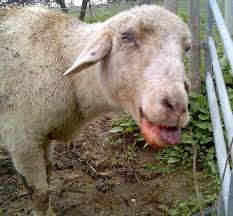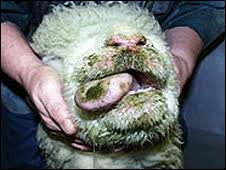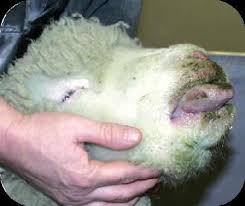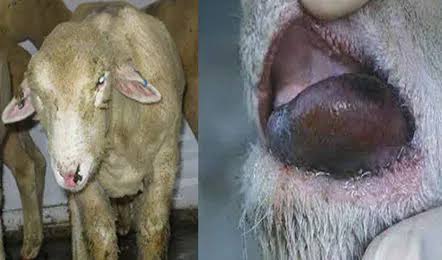Bluetongue disease, scientifically known as “Epizootic Hemorrhagic Disease” (EHD), is a viral illness that affects ruminant animals like sheep, cattle, and deer. This disease is transmitted by Culicoides biting midges, small insects that carry and spread the virus. Bluetongue is named after one of its notable symptoms, the bluish discoloration of the tongue and mucous membranes in affected animals.
The virus responsible for Bluetongue belongs to the Orbivirus genus, and there are multiple serotypes, or variations, which can cause different levels of severity in infected animals. These viruses primarily target the animal’s vascular and lymphatic systems, leading to fever, swelling, and ultimately, serious health complications.
Bluetongue disease is prevalent in many parts of the world, with variations in its impact depending on the region and the specific serotype involved. One of the key challenges in controlling Bluetongue is the wide distribution of its vector, the Culicoides midge, which can cover vast geographical areas.
The clinical signs of Bluetongue vary, but common symptoms include lethargy, lameness, and swelling of the face and neck. Infected animals may also exhibit respiratory distress and, in severe cases, can succumb to the disease. Additionally, Bluetongue can negatively impact reproduction in affected livestock, leading to economic losses for farmers.
Efforts to manage and control Bluetongue involve strategies such as vaccination, vector control, and movement restrictions on infected animals. Vaccination helps to reduce the severity of the disease and limit its spread, but developing effective vaccines can be challenging due to the various serotypes of the virus.
In regions where Bluetongue is endemic, farmers often implement practices to minimize contact between livestock and Culicoides midges. This may include adjusting grazing patterns, using insecticides, and employing other preventive measures to reduce the risk of transmission.
Global cooperation is essential for addressing Bluetongue, as the movement of livestock and vectors across borders can contribute to the spread of the disease. Veterinary authorities and researchers collaborate to monitor and control outbreaks, sharing information and implementing measures to prevent further dissemination.
Bluetongue disease, or Epizootic Hemorrhagic Disease, poses a significant threat to ruminant animals worldwide. Its complex nature, involving both viral dynamics and vector biology, makes effective management a challenging task. Ongoing research, surveillance, and international collaboration are crucial components in the fight against this impactful livestock disease.
Read Also: How to Raise Ruminant Animals for Fattening and Reproduction together
Animals Affected by Bluetongue Disease (Epizootic Hemorrhagic)

Bluetongue disease primarily affects ruminant animals, which are mammals with complex stomachs that chew cud. The most commonly affected animals include:
1. Sheep: Sheep are highly susceptible to Bluetongue, and the disease can have a significant impact on flocks. Infected sheep may exhibit symptoms such as fever, lameness, and swelling, with the characteristic bluish discoloration of the tongue.
2. Cattle: Bluetongue can also affect cattle, causing similar symptoms as in sheep. Infected cattle may experience fever, nasal discharge, and swelling of the head and neck. In severe cases, the disease can lead to weight loss and decreased milk production.
3. Goats: While goats can be infected with Bluetongue, they are generally less susceptible than sheep and cattle. The severity of the disease in goats can vary, and symptoms may include fever, lethargy, and respiratory distress.
4. Deer: Wild and domesticated deer can be affected by Bluetongue, experiencing symptoms such as swollen tongues, lameness, and a decline in overall health. The impact on deer populations can be significant, especially in areas where the disease is prevalent.
5. Wildlife: Bluetongue has been reported in various wild ruminants, including antelope, bison, and elk. The disease can have implications for wildlife populations, affecting their health and potentially influencing ecosystem dynamics.
It’s important to note that different species may exhibit varying levels of susceptibility to Bluetongue, and the severity of the disease can be influenced by factors such as the specific serotype of the virus and the overall health of the animals. Control measures often involve vaccination, vector management, and movement restrictions to limit the spread of the disease among susceptible populations.
Damages Caused by Bluetongue Disease

Bluetongue disease can cause a range of damages, affecting both individual animals and the livestock industry as a whole. The impacts include:
1. Animal Health: Infected animals can experience various health issues, including fever, lameness, swelling, and respiratory distress. The characteristic bluish discoloration of the tongue is a notable sign. In severe cases, Bluetongue can lead to weight loss, reduced milk production, and even death, particularly in sheep and cattle.
2. Reproductive Issues: Bluetongue may negatively impact reproduction in infected animals. This can result in decreased fertility, abortion, and stillbirths. These reproductive losses can have economic implications for farmers, affecting the overall productivity of their livestock.
3. Economic Losses for Farmers: The disease can lead to significant economic losses within the livestock industry. Infected animals may require veterinary care, and the decreased productivity, including lower milk production and reproductive issues, can affect a farmer’s income. Moreover, movement restrictions and trade limitations may further impact the economic viability of livestock operations.
4. Impact on Trade: Bluetongue can have trade implications, as countries may impose restrictions on the movement of livestock and related products to prevent the spread of the disease. This can affect international trade relationships and contribute to market disruptions.
5. Wildlife Population Effects: Bluetongue is not limited to domesticated animals and can affect wild ruminants. In certain regions, the disease can impact wildlife populations, potentially disrupting ecosystem dynamics and biodiversity.
6. Control Costs: Implementing control measures, such as vaccination campaigns and vector control programs, involves additional costs for farmers and governmental authorities. Developing and maintaining effective vaccines for the various serotypes of the virus can be a challenging and ongoing process.
7. Challenges in Vector Control: Controlling the Culicoides midge, the vector responsible for transmitting Bluetongue, can be challenging due to the insects’ widespread distribution. Insecticides and other vector management strategies may be necessary but can add to the overall cost and logistical challenges of disease control.
Addressing the damages caused by Bluetongue requires a multifaceted approach, involving coordinated efforts in surveillance, vaccination, vector control, and international cooperation. By mitigating the impacts of the disease on animal health, reproduction, and the economic aspects of the livestock industry, stakeholders aim to reduce the overall burden of Bluetongue.
Read Also: Popular Breeds of Ruminant Animals
Control and Preventive Measures

Controlling and preventing Bluetongue disease involves a combination of strategies aimed at managing both the viral agent and its vector. Here are key measures implemented to control and prevent Bluetongue:
1. Vaccination Programs: Developing and implementing effective vaccines is a primary strategy for controlling Bluetongue. Vaccination helps reduce the severity of the disease in infected animals and can prevent the spread of the virus within livestock populations. However, developing vaccines for multiple serotypes of the virus remains a challenge.
2. Vector Control: Since Culicoides biting midges play a crucial role in transmitting the Bluetongue virus, controlling their populations is essential. This may involve the use of insecticides, environmental management practices, and other measures to reduce midge breeding sites. However, the wide distribution of Culicoides species poses challenges in achieving complete vector control.
3. Movement Restrictions: Implementing restrictions on the movement of livestock can help prevent the spread of Bluetongue. This is particularly important in areas where the disease is prevalent or during outbreaks. Controlling the movement of infected animals reduces the risk of introducing the virus to new regions.
4. Surveillance and Monitoring: Regular surveillance of livestock populations is crucial for early detection of Bluetongue cases. Monitoring the prevalence and distribution of the disease allows for timely intervention and the implementation of control measures. Additionally, international cooperation in sharing surveillance data contributes to a broader understanding of the disease’s dynamics.
5. Quarantine Measures: Quarantine measures for infected and at-risk animals can help contain the spread of Bluetongue. Isolating and treating affected animals can prevent the introduction of the virus to healthy livestock populations.
6. Research and Development: Ongoing research into the biology of the Bluetongue virus, the Culicoides vector, and vaccine development is essential for improving control strategies. Advancements in understanding the various serotypes of the virus contribute to the development of more effective preventive measures.
7. Public Awareness and Education: Educating farmers, veterinarians, and other stakeholders about the signs of Bluetongue, its transmission, and preventive measures is crucial. Increased awareness promotes early reporting of suspected cases and encourages the adoption of preventive practices by those involved in livestock management.
8. International Collaboration: Bluetongue is a global concern, and international collaboration is vital for addressing the disease. Sharing knowledge, resources, and coordinated efforts between countries enhance the overall effectiveness of control and preventive measures.
By combining these strategies, stakeholders aim to reduce the impact of Bluetongue on animal health, minimize economic losses for farmers, and mitigate the potential for international spread. Continuous adaptation of control measures based on scientific advancements and epidemiological insights is essential for effective management of Bluetongue disease.
Frequently Asked Questions (FAQs) About Bluetongue Disease (Epizootic Hemorrhagic)
1. Q: What is Bluetongue disease?
A: Bluetongue disease, scientifically known as Epizootic Hemorrhagic Disease (EHD), is a viral illness that primarily affects ruminant animals like sheep, cattle, and deer. It is transmitted by Culicoides biting midges.
2. Q: What are the symptoms of Bluetongue in animals?
A: Symptoms include fever, lameness, swelling, respiratory distress, and a bluish discoloration of the tongue. In severe cases, the disease can lead to weight loss, decreased milk production, and reproductive issues.
3. Q: How is Bluetongue transmitted?
A: Bluetongue is transmitted through the bites of infected Culicoides midges. These small insects serve as vectors, carrying and transmitting the virus from infected to susceptible animals.
4. Q: Can Bluetongue affect humans?
A: No, Bluetongue is not known to affect humans. It is specific to ruminant animals and does not pose a direct health risk to people.
5. Q: Which animals are most susceptible to Bluetongue?
A: Sheep, cattle, goats, and deer are among the most susceptible to Bluetongue. Wild ruminants, such as antelope and bison, can also be affected.
6. Q: How can Bluetongue be controlled and prevented?
A: Control measures include vaccination programs, vector control to manage Culicoides midges, movement restrictions, surveillance, and international collaboration. These strategies aim to reduce the spread of the virus and minimize its impact on livestock.
7. Q: Is there a vaccine for Bluetongue?
A: Yes, vaccines for Bluetongue are available and are an essential part of disease control programs. However, developing effective vaccines for all serotypes of the virus remains a challenge.
8. Q: What should I do if I suspect Bluetongue in my livestock?
A: If you suspect Bluetongue, contact a veterinarian promptly. Isolate affected animals, report the suspected cases to relevant authorities, and follow recommended quarantine and control measures.
9. Q: Can Bluetongue be transmitted through animal products like meat or milk?
A: No, Bluetongue is not transmitted through consumption of meat or milk from infected animals. The virus is primarily spread through the bites of infected Culicoides midges.
10. Q: How can farmers protect their livestock from Bluetongue?
A: Farmers can protect their livestock by participating in vaccination programs, implementing vector control measures, and adhering to movement restrictions. Regular surveillance and early reporting of suspected cases are also important for timely intervention.
Read Also: How to Make Your Own Organic Pesticides

